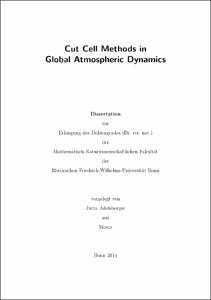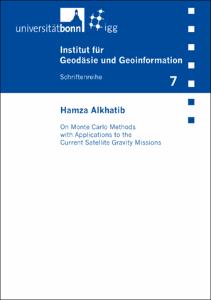Adelsberger, Jutta: Cut Cell Methods in Global Atmospheric Dynamics. - Bonn, 2014. - Dissertation, Rheinische Friedrich-Wilhelms-Universität Bonn.
Online-Ausgabe in bonndoc: https://nbn-resolving.org/urn:nbn:de:hbz:5n-35280
Online-Ausgabe in bonndoc: https://nbn-resolving.org/urn:nbn:de:hbz:5n-35280
@phdthesis{handle:20.500.11811/6049,
urn: https://nbn-resolving.org/urn:nbn:de:hbz:5n-35280,
author = {{Jutta Adelsberger}},
title = {Cut Cell Methods in Global Atmospheric Dynamics},
school = {Rheinische Friedrich-Wilhelms-Universität Bonn},
year = 2014,
month = feb,
note = {In this thesis, we study next generation techniques for the numerical simulation of global atmospheric dynamics, which range from modeling and grid generation to discretization schemes.
Based on a detailed dimensional analysis of the compressible three-dimensional Navier-Stokes equations for small- and large-scale motions in the atmosphere, we derive the compressible Euler equations, the dynamical core of meteorological models. We also provide an insight into multiscale modeling and present a new numerical way of deriving reduced atmospheric models and gaining consistency of the modeling and discretization errors.
The main focus of this thesis is the grid generation of the atmosphere. With regard to newly available surveys of the Earth's surface and the ever increasing computing capacities, the atmospheric triangulation techniques have to be reconsidered. In particular, the widely-used terrain-following coordinates prove to be disadvantaguous for highly resolved grids, since both the pressure gradient force error and the hydrostatic inconsistency of this vertical ansatz seriously increase with finer resolution.
After a detailed analysis of the standard methods for vertical atmospheric triangulations, we present the cut cell approach as capable alternative. We construct a special cut cell method with two stabilizing constraints and provide a comprehensive guideline for an implementation of cut cells into existing atmospheric codes.
For the spatial discretization of the dynamical core, we choose the Finite Volume method because of its favorable characteristics concerning conservation properties and handling of hyperbolicity. We accompany the Finite Volume discretization by a new non-linear interpolation scheme of the velocity field, which is adapted to the geometry and rotation of the Earth.
To fathom the capabilities of cut cell grids together with our discretization and new interpolation scheme, we finally present several three-dimensional simulation runs. We apply standard benchmarks like an advection test and the simulation of a Rossby-Haurwitz wave and construct a new test case of counterbalancing flow between high- and low-pressure areas, with which we expose the potential of cut cell methods and the influences of different effects of the Euler equations as well as the topography of the Earth.},
url = {https://hdl.handle.net/20.500.11811/6049}
}
urn: https://nbn-resolving.org/urn:nbn:de:hbz:5n-35280,
author = {{Jutta Adelsberger}},
title = {Cut Cell Methods in Global Atmospheric Dynamics},
school = {Rheinische Friedrich-Wilhelms-Universität Bonn},
year = 2014,
month = feb,
note = {In this thesis, we study next generation techniques for the numerical simulation of global atmospheric dynamics, which range from modeling and grid generation to discretization schemes.
Based on a detailed dimensional analysis of the compressible three-dimensional Navier-Stokes equations for small- and large-scale motions in the atmosphere, we derive the compressible Euler equations, the dynamical core of meteorological models. We also provide an insight into multiscale modeling and present a new numerical way of deriving reduced atmospheric models and gaining consistency of the modeling and discretization errors.
The main focus of this thesis is the grid generation of the atmosphere. With regard to newly available surveys of the Earth's surface and the ever increasing computing capacities, the atmospheric triangulation techniques have to be reconsidered. In particular, the widely-used terrain-following coordinates prove to be disadvantaguous for highly resolved grids, since both the pressure gradient force error and the hydrostatic inconsistency of this vertical ansatz seriously increase with finer resolution.
After a detailed analysis of the standard methods for vertical atmospheric triangulations, we present the cut cell approach as capable alternative. We construct a special cut cell method with two stabilizing constraints and provide a comprehensive guideline for an implementation of cut cells into existing atmospheric codes.
For the spatial discretization of the dynamical core, we choose the Finite Volume method because of its favorable characteristics concerning conservation properties and handling of hyperbolicity. We accompany the Finite Volume discretization by a new non-linear interpolation scheme of the velocity field, which is adapted to the geometry and rotation of the Earth.
To fathom the capabilities of cut cell grids together with our discretization and new interpolation scheme, we finally present several three-dimensional simulation runs. We apply standard benchmarks like an advection test and the simulation of a Rossby-Haurwitz wave and construct a new test case of counterbalancing flow between high- and low-pressure areas, with which we expose the potential of cut cell methods and the influences of different effects of the Euler equations as well as the topography of the Earth.},
url = {https://hdl.handle.net/20.500.11811/6049}
}









